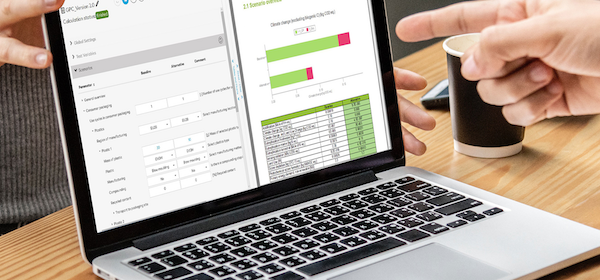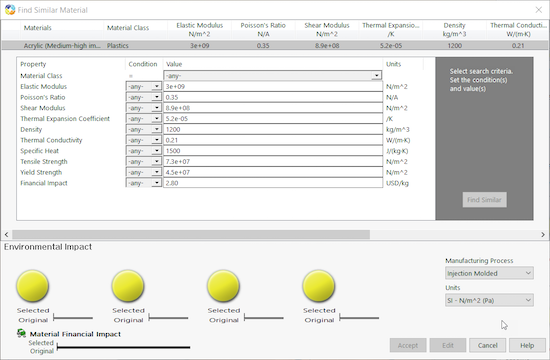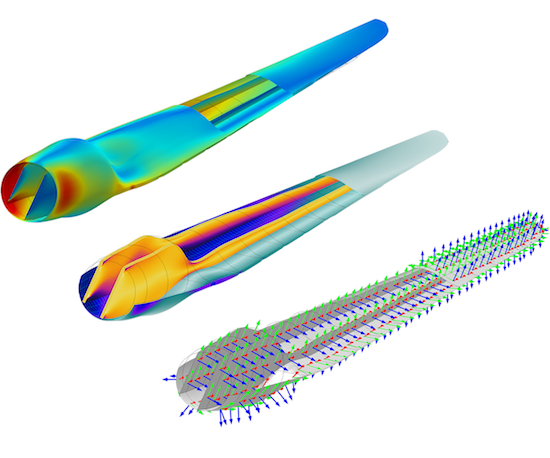Tools that Build Sustainable Products
Design solutions are emerging that can help integrate sustainability.

Fig. 1: Sustainable design represents a cradle-to-grave development process that adds significant complexity to the creation of new products. To help the engineer with this task, design software providers have introduced new tools. One of these is the GaBi packaging calculator, a web-based tool that allows designers to create lifecycle assessments and to simulate the use of alternative materials or processes in design scenarios. Image courtesy of Sphera.
Latest News
July 1, 2020
Environmental awareness, government regulatory demands, market pressure to cut production costs—these factors are driving companies to take a closer look at sustainable product design.
This product development approach has started to change the way companies think about products, processes and business models, holding out the promise of competitive advantages. But even with these inducements, simply taking preliminary steps toward adopting sustainable design can be daunting. A primary barrier to moving forward seems to be finding the right tools for the job.
Unfortunately, the search for the best software platforms to perform sustainable design tasks can be confusing. Engineers and their employers must weigh the pros and cons of several options and then hopefully select the most effective toolset.
Cradle to Grave
One type of software platform in particular has begun to cast a long shadow in this arena. Lifecycle assessment (LCA) tools tap the strengths of traditional technologies like modeling, simulation and databases, with an eye toward shedding light on all phases of a product’s lifecycle and providing the insights required to make effective green design decisions.
LCA platforms begin assessments in the early stages of the design process, calculating the environmental risks and optimization potential of products, as well as identifying the stages likely to cause the greatest environmental burden (Fig. 1).
The first step of this process calls for engineers to define the product and its lifecycle and describe the product’s operating environment and function parameters. When these tasks have been accomplished, development teams then identify all raw materials that go into creating the product and model and simulate their impact on the environment as they pass through the various stages of its lifecycle.
The models and simulations connect successive processes with material flows, building the process chain. Each process represents a stage in the product’s lifecycle and is defined by its input and output. The software uses the output from a preceding process to build the input for the next. Simple process chains can be modeled in a single layer, but more complex chains require a hierarchical structure.
Gauging Environmental Indicators
These various analysis stages define the “normalized environmental effects,” as the product moves through each stage of its lifecycle. The results are grouped in environmental impact categories, which include air acidification, carbon footprint, energy consumed and water eutrophication (imbalance of minerals in water that leads to excessive algae). Each impact category affects the environment to a degree. For example, global warming naturally refers to a global scale, where air acidification like acid rain occurs regionally or locally.
LCA software combines all emissions, product stages, and scales into the most significant impact categories. This provides the engineer with an overview, helps determine when ecological action should be taken, and identifies the most efficient measures for adjustment.
To create a holistic product view, the designer must achieve the right balance between data volume and quality.
“Keep in mind that without the right amount of specifications—such as material amounts and types—results will be too vague or imprecise to give meaningful direction to the user. Ask for too many details, like a supplier’s name at Tier 3, and you risk losing your users due to the effort it takes to provide the required information.” says Flora D’Souza, a senior consultant at Sphera.
In weighing the data’s value, it’s important to consider that geography can also play a role in sustainability. For example, parts can be manufactured in one region, go through a final assembly process in another and then be operated or used in a third location. All logistics complexities affect the cost and environmental impact of the part. This can be seen when energy consumption is considered. Depending on the type of power plant used for power generation, the production of 1 kWh has a different impact on the environment from one region to the next.
Choosing the Right Stuff
The material used to fabricate a product represents a key parameter used to define the normalized environmental effects and to gauge the environmental impact of a product design. The creation of the raw material, transforming the material in the manufacturing process, performing predictive maintenance and end-of-life handling—all these activities must be considered when selecting a material for a sustainable design.
For example, carbon fiber can experience cracks/delaminations after years of use, causing the user to replace it several times during the life of the product. Choosing another material may mitigate the environmental impact, reduce maintenance costs and extend the life of the product (Fig. 2).
Beginning early in the design process, the product developer must optimize the materials used in the design to have a minimal impact on the environment. A first step includes considering and comparing materials based on their environmental footprints, ease of production, ease of disassembly and recycling and re-use in new products.
To make the right choice, the LCA software should support what-if scenarios. Assessments on the different tradeoffs provide guidance for the designer.
For example, a proposed material may be stronger, so the part geometry can be changed to use less material—for example, allowing for thinner walls. Changing the material and the product’s geometry, however, may increase the manufacturing cost of the product, but reduce the environmental impact of the design. Therefore, the designer must interpret and value a wide range of outputs during the material selection process. Unfortunately, the choice is never black and white; this reinforces the value of the full lifecycle analysis.
Though the selection of the material greatly affects a design’s sustainability, it is important to keep an eye on the big picture and not lose sight of the tradeoffs that have to be made for a particular product and its functional requirements.
“While material is an important consideration in sustainability, simply having a material recommendation tool for sustainability is oversimplification,” says Prashant Jagtap, president of Trayak. “In fact, it can even lead to wrong results. A complete lifecycle analysis that also considers the performance characteristics of the product in a combined holistic analysis will give better results.”
Packaging Offers Big Rewards
Discussions of sustainable product design often focus on LCA and material optimization, but can forget about packaging design. There is, however, a price to be paid for this oversight. A development team may work hard to optimize the sustainability of the actual product, only to have a packaging designer create what might be called a “wasteful or excessive” set of packaging.
To avoid this pitfall, many sustainable design platforms have made packaging a part of the overall design process. To help with the evaluation of packaging designs, LCA vendors sometimes include packaging calculators.
For example, the GaBi packaging calculator is a web-based LCA configuration tool that allows engineers simulate alternative packaging designs. A key feature of the tool is a parameterized LCA model that traces the packaging throughout its lifecycle.
For such calculators to be effective, they must provide actionable results.
“The results have to be specific enough to enable engineers to make the right choices for their product and provide a good overview of different sustainability metrics,” says D’Souza. “For example, the GaBi packaging calculator gives a long list of environmental impact categories, as well as packaging-specific indicators.”
These calculations should include end-of-life considerations.
“Today, packaging companies are looking at stepping away from plastic and putting more emphasis on end of life and recyclability,” says Zoé Bezpalko, sustainability strategy manager at Autodesk. “It is therefore quite important for designers to understand the impact of their packaging decisions. More sustainable packaging is not only driven by more sustainable materials—like recyclable or compostable materials—but also by the end-of-life considerations like the capacity and feasibility to recycle or disassemble and repair it.”
Another important consideration with packaging design is the software’s ability to work with traditional design tools.
“Integration of sustainability assessment software with 3D CAD and simulation software can significantly help with more highly engineered packaging requirements,” says Eric Leafquist, 3DEXPERIENCE WORKS senior portfolio manager at Dassault Systèmes. “Examples include packaging delicate products, such as consumer electronics or food products like as eggs. It can also help with more tightly integrated, nestable products and individually packaged products that must be integrated into over-packaging for bulk shipments.”
Packaging improvements may be the fastest and easiest way to improve the environmental impact of high-volume consumer products or highly regulated medical devices.
The Importance of Access
Lifecycle analysis, material optimization and sustainable packaging design must have the right quality and quantity of data to succeed. As a result, engineers choosing an LCA platform should be sure that the software has the ability to access all of the inputs that go into creating, transporting, operating and disposing of the product.
This requires accessing pools of data containing various design, materials, manufacturing and environmental data, often from external, siloed data repositories that don’t always support communications with other systems. Unfortunately, this is where the design workflow and information can become dicey.
“The problem any designer will face is that the raw information is found in many siloed systems that are not communicating,” says Alexandre Laloi, senior manager, CATIA business applications, at Dassault Systèmes. “EIS, ERP, PDM, PLM [enterprise information system, enterprise resource planning, product data management, product lifecycle management]—none of these systems are linked. The tool should be able to extract the needed information from all those silos to build a consolidated impact to present to the designer.”
This is where integration and interaction with external systems becomes important.
“The software should enhance the designers’ field of vision by providing them with information they did not have access to before sustainable choices, on a platform that only asks for data they already have at hand,” says D’Souza.
Leveraging External Toolsets
This review of LCA and material optimization processes drives home just how much sustainable design can increase the design engineer’s workload, adding a level of complexity that often makes companies reluctant to make the transition. Market watchers contend that easy integration of tools like LCA platforms with more traditional toolsets streamlines the transition and removes adoption hurdles.
“From our user research, we know that the more integrated the tools for sustainability are, the more useful they are,” says Bezpalko. “Designers already have many competing priorities—cost, form, and user experience—and sustainability can often feel like an add-on if it requires too much effort to integrate.”
In addition, successful sustainable design involves many refinements and tradeoff decisions. These include design geometry, functionality, appearance, strength, manufacturability, delivered cost, and environmental impact. The best way to accomplish all these design cycles is to use sustainability assessment tools that can work efficiently with other types of design software.
“PLM and CAD workflow and tools that a designer uses are key,” says Trayak’s Jagtap. “If a sustainable software can integrate with many of them, it makes the designer’s job easier. Data entry, collaboration, and incorporating milestones for design or engineering change releases become fluid and easy. In addition to that, if the sustainable software can integrate with other IT systems like spec management, ERP, or other business systems containing supplier and sales data, then the sustainability software can truly help you mainstream sustainability into your organization.”
More Autodesk Coverage
More COMSOL Coverage
More Dassault Systemes Coverage

Subscribe to our FREE magazine, FREE email newsletters or both!
Latest News










